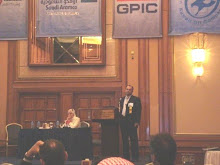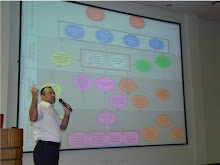Abstract
Strategy symbolizes the transfer of an organization from its current state to a desired new future one. This implies high uncertainty and risks in “how” to go there.
This paper aims to provide a road-map that decreases this uncertainty by a comprehensive set of tools to plan the strategy then select and maintain the right portfolio of projects that best aligns with this strategy.
The framework presented hereafter will ensure sound strategic planning, optimize organizational resources, and guarantee projects’ strategic alignment, at the outset and throughout their lifecycles. Benefits will extend into enhancing communication among organizational units, and supporting governance.
The three main components of this framework are:
• Strategic Planning and Mapping to develop and communicate strategy;
• Strategic Implementation by portfolio management;
• Tools and Techniques to assess strategic alignment at decision gate meetings.
1 Executive Summary
In many organizations, little emphasis has been given to strategic planning and strategic alignment of projects undertaken. In most cases, adopted strategies were ‘diversified’ and not developed in structured ways to accomplish preset main goals on one side and facilitate projects’ selection on the other. Projects were pipelined to accomplish certain objectives like increased profitability, competitive advantage etc. However, selecting the right projects and prioritizing them has been a big challenge.
We are going to show how strategic planning, that involves middle managers (expertise) and strategic planners (catalysts) can be the benchmark of strategic alignment.
Then a strategic map will visualize the desired strategy on a balanced scorecard, highlighting the cause-and-effect relation between projects and desired strategic objectives.
Once strategy is set and communicated, we recommend adopting the portfolio management process for selecting the right balance of projects and involving executives in the gating process which provides an objective mechanism to weigh, assess alignment, and then prioritize all projects for rigid GO-Kill decisions. Using this mechanism at a series of preset phases will enable innovation and growth while preventing resources from being wasted on projects that lack strategic alignment.
2 Strategic Planning
The target is to have strategically driven organization where all projects lie under the strategic umbrella. Though characterized by their individual goals, projects’ overall benefits exceed the sum of individual ones i.e. 1+1=3!
Sections below elaborate how to achieve this target.
2.1 Strategy Making
In this process, executives and middle managers use soft data (expertise) and hard data (numbers) to develop the vision of where the organization should go. The strategic planners support them by acting as catalysts that contribute to this process and enable strategy making (Mintzberg, 1994). We can identify two kinds of strategic planners:
• Right handed planners are analytics, they like tidiness and order.
• Left handed planners are creative, untraditional, and unpredictable.
Middle managers and executives will be more able to focus on analyzing data that was developed by planners, and on strategic decision making.
Planners’ major role is around the strategy making process not in it. They perform statistics, competitive analysis, researches, etc. and the overall responsibility should reside with business managers.
We can espouse the comprehensive framework presented in figure below then tailor it to our specific needs (Mintzberg H., 2004).
In the strategy making process, these two roles complement each other. Managers are too busy for reflection or documenting findings. This may lead to information loss. However, planners are there to capture this data.
Strategy can be deliberate or emergent. Deliberate strategy is made be senior management based on their intents, whereas emergent strategies are the “overall result” now of initiatives undertaken before. It is recommended to keep the deliberate strategic decisions “broad”; which allows for tuning and aligning by integrating emerging changes as we progress with the strategy making and implantation (Mintzberg, 1994).
Once the strategic plan is set and approved, we need to communicate the vision and strategy to have everyone in the organization looking in the same direction. How? By Drawing a Strategy map!
2.2 Strategy Mapping
Strategy Map is a tool to communicate strategy and a process to implement this strategy:
• It gives everyone in the organization a clear view of how this strategy leads to organizational objectives.
• Understanding how each person’s job links to the overall desired outcome.
• Represents a Cause-and-effect diagram between initiatives and the benefits to be realized.
The Balanced Scorecard shown below represents a strategy map. It looks at the organizational strategy from four perspectives: Financial, Customer, Internal Processes and Learning & Growth (Kaplan et al, 2000).
The balanced scorecard tells us what competencies our employees will need (Learning & Growth) to innovate and build the right organizational capabilities and efficiencies (our internal processes) that deliver specific value to the market (our customers) which eventually leads to higher revenues and shareholder value (Financials).
This strategy map will enable the organization to view its strategy in an integrated way. Consequently, gaps, miss-alignments, or conflict between strategic initiatives will surface. Solution… The feedback loops.
3 Portfolio Management
3.1 Why Portfolio Management?
Now we have a set of strategic and business initiatives that need to be managed successfully in a “collective manner” to realize the strategic objectives. Portfolio Management is the key tool (Gerrand, 2004).
Portfolio Management is a necessary core competence for medium and large organizations. It is seen as a dialogue between organizational units of different concentration, especially the business and implementation units.
How does Portfolio Management help achieving the strategic goals?
1. It provides an integrated view of all strategic objectives of business, implementation, and corporate groups.
2. And a mechanism for these objectives to be clarified and optimized before expensive implementation.
3. Select and approve objectives that best fit organizational strategy and
4. Ensure that the implementation projects remain aligned as we progress.
5. Allows for planning and optimizing all types of resources needed in advance.
3.2 Portfolio Management Principles
3.2.1 Single-Point Accountability for Portfolio Management with “one” business owner (probably business or corporate unit).
3.2.2 Establish a Portfolio Governance Group (PGG) composed of the heads of all divisions for collective portfolio decision-making (corporate, business, operations, technology, etc.) and driving the portfolio as shown in figure below (Gerrand, 2004).
3.2.3 Gates to Ensure Continuous Strategic Alignment of initiative. The PGG evaluates the initiatives at each stage gate through their lifecycle.
Figure below demonstrates the five main GO/NO-GO decision gates and where they occur in the strategic initiatives’ lifecycle (now becoming projects!).
It is vital to identify miss-aligned projects as early as possible and “kill them” when their cost is still low (Cooper et al, 2002).
3.2.4 Tools for Assessment and Prioritization, these tools are integral parts of sound project management methodology. Portfolio Management is thus using existing data to optimize organizational resources.
Figure below shows what tools can be useful at which stage of the initiative lifecycle (Gerrand, 2004). Organizations can select other tools according to their industry, business directions and working environment.
4 The Gate Meetings
Gate meetings keep executives engaged in the process on one hand and use objective assessment criteria at specific stages on the other. These meetings are conducted on a two-stage basis.
The first Stage is to assess each project and make a “GO-KILL” decision based on preset must meet and should meet criteria.
The second stage is to assess the impact of proceeding with this project on the overall portfolio. In this case, a decision to Go-Live/Hold is made.
5 Conclusion
Finally, it is worth mentioning that the framework presented above builds on and uses deliverables of sound project management methodology like feasibility studies, business cases, risk registers, progress reports, etc. Organizations are expected to have a mature project management methodology set in place and of more importance… to be actually implemented.
________________________________________
6 References
• Mintzberg H., (1994), “The Fall and Rise of Strategic Planning”, Harvard Business Review, Jan-Feb 2004, pp. 107-114.
• Kaplan R.S. & Norton D. P., (2000), “Having Trouble with Your Strategy? Then Map It”, Harvard Business Review, Sep-Oct 2000, pp. 167-176.
• Cooper R.G., Edgett S. J. and Kleinschmidt E. J., (2002), “Optimizing the Stage-Gate Process: What Best-Practice Companies DO-II”, Industrial Research Institute, Nov-Dec 2002, pp. 43-49.
• Gerrand J. (2004) “Portfolio and Programme Management”, PMGT6870, Project Management Graduate Programme, University of Sydney, pp. 4-20.
About The Author

- Eng. Samer el Barakeh, MPM, PMP
- Samer el Barakeh was born in Lebanon, 1973. He completed his Bachelor in Engineering-CCE at Beirut Arab University-Lebanon in 1996 with honours. Samer was granted Masters Degree in Project Management (MPM) from the University of Sydney-Australia with honours. He also gained the Project Management Professional (PMP) Credential from The Project Management Institute (PMI). Samer is a member of the Order of Architects and Engineers in Lebanon since 1996, The Project Management Institute (PMI), Arabian Gulf Chapter (AGC-PMI) and Lebanon Chapter-PMI. During his 13 years of professional experience in Lebanon, Australia and Saudi Arabia, Samer held many positions among them: Telecommunication Site Engineer, Site Manager, Low Current Service Head, and he is currently Senior Systems Analyst at the General Project Construction Division. Samer is a Project Management Consultant and Training Provider for universal organizations like Business Management Consultants (USA) www.bmc-online.com and PMCTQuest (Canada) www.pmctquest.com Samer is a Registered Training Provider for Project Management Professional (PMP), and he provides training in Program Management, Portfolio Management,PMO...
Select a topic to view content
- A comparison between PMBOK and Prince2 Methodologies and reflection on case study examples (1)
- ABC to Avoid Project Failure (1)
- Business Case and Quantitative Benefits (1)
- Do we need more 'Planners' ? (1)
- Fasilitator in Partnering-A Coincise Shot (1)
- How to Ensure Stratgic Alignment of Our Projects? (1)
- Individual Dissimilarity and Team Work (1)
- Knowledge Management (1)
- Maturity Models-The Pros and Cons (1)
- Organizational Advantages from Partnering (1)
- Organizational Maturity: Lets Head Upwards... (1)
- Organizational Strategy and Project Alignement (1)
- Practical Solutions 1 of 6: Introduce RMMM (1)
- Practical Solutions 2 of 6: Facilitate Change to Perk up Maturity (1)
- Practical Solutions 3 of 6: Leverage Organisational Culture Barrier (1)
- Practical Solutions 4 of 6: Organisational Cultural Alignment (1)
- Practical Solutions 5 of 6: Defining a Unified Decision Making Tool (1)
- Practical Solutions 6 of 6: Understanding The Paradox of Control (1)
- Programme Management to Implement Strategy (1)
- Project Management and Construction Management (1)
- Project Managers relocated before Proper Project Closure and Learning Lessons (1)
- Project Managers' Power (1)
- Strategic Planning (1)
- Successful Project Management Office-PMO (1)
- System Thinking: Archetypes at Work... (1)
- The Partnering Change Process (1)
- The Upper Hand… Leadership skills or Processes? (1)
- Thinking about change needed? Maybe you should be more ‘worried’ about how to make it real (1)
- Vision Mission and Objectives What and Why? (1)
- What is meant by Portfolio and Programme Management (1)
- Why Partnering in Organizations? (1)
October 25, 2008
Organizational Strategy and Project Alignment
Posted by
Eng. Samer el Barakeh, MPM, PMP
at
4:28 PM
![]()
![]()
Subscribe to:
Post Comments (Atom)
Followers
All Titles
A comparison between PMBOK and Prince2 Methodologies and reflection on case study examples
ABC to Avoid Project Failure
Business Case and Quantitative Benefits
Do we need more 'Planners' ?
Fasilitator in Partnering-A Coincise Shot
How to Ensure Stratgic Alignment of Our Projects?
Individual Dissimilarity and Team Work
Knowledge Management
Maturity Models-The Pros and Cons
Organizational Advantages from Partnering
Organizational Maturity: Lets Head Upwards...
Organizational Strategy and Project Alignement
Practical Solutions 1 of 6: Introduce RMMM
Practical Solutions 2 of 6: Facilitate Change to Perk up Maturity
Practical Solutions 3 of 6: Leverage Organisational Culture Barrier
Practical Solutions 4 of 6: Organisational Cultural Alignment
Practical Solutions 5 of 6: Defining a Unified Decision Making Tool
Practical Solutions 6 of 6: Understanding The Paradox of Control
Programme Management to Implement Strategy
Project Management and Construction Management
Project Managers relocated before Proper Project Closure and Learning Lessons
Project Managers' Power
Strategic Planning
Successful Project Management Office-PMO
System Thinking: Archetypes at Work...
The Partnering Change Process
The Upper Hand… Leadership skills or Processes?
Thinking about change needed? Maybe you should be more ‘worried’ about how to make it real
Vision Mission and Objectives What and Why?
What is meant by Portfolio and Programme Management
Why Partnering in Organizations?

















No comments:
Post a Comment